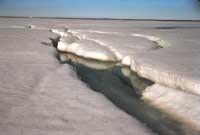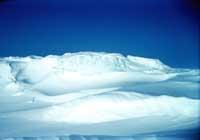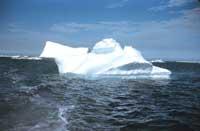The Arctic Ocean, less and less ice
North and South Pole: two worlds of ice, but completely different worlds. In the South Pole is Antarctica, a spectacular continent hidden under the ice. In the North Pole, the Arctic Ocean; that is, in the North Pole, we will find little land and much water, a mass of water that has much to say in the world climate.

The Arctic Ocean is an icy ocean further north of the Arctic Circle. 14,000,000 square kilometers of surface, 988 meters of average depth and 5,502 meters of maximum depth, making it the smallest and least deep ocean in the world. In addition, it is a fairly closed ocean, as Eurasia, North America and Greenland surround it almost completely. The Arctic Ocean has on it a permanent ice sheet that conditions its physical, chemical and biological characteristics. According to the times, this layer of ice will cover a larger or smaller surface, with limits further south in cold winter and, of course, further north in summer. But far north, above 75 degrees of latitude, ice is usually constant. The Arctic Ocean and the Atlantic Ocean link the steps between Greenland and the Norwegian archipelago Svalbard, from where cold waters affect the average temperature of the world's oceans and the world's global climate. The cold waters of the Arctic Ocean propel, for example, the Gulf Stream, one of the engines of the mild climate that we live in western Europe.
Just as the Arctic Ocean affects climate, climate and climate change have a great influence on the Arctic. The local ice sheet, sufficient to cover the United States, is very sensitive to the changes in the underlying air and oceans, making it a common reference for all climate change researchers. The researchers were convinced that the ice sheet covering the Arctic Ocean has less surface year after year, but the process was worrying but not disturbing. The surface of the frozen ocean during the summer has declined by 3% for decades in recent years, but at that speed it would take 350 more years to see the Arctic Ocean totally free of ice in summer. However, the new measurements have revolutionized these calculations and announced that we will be able to see with our eyes the aforementioned “show”.

Satellite and submarine measurements made between 1978 and 1998 indicate that the Arctic ice sheet is rapidly thinning and rejuvenating. The satellite collects waves emitted by surface ice and can determine whether the ice is recent or ancient depending on its nature, while submarines measure its consistency by sound waves. But the consequences for us more than research methods are important and the consequences point to that in the last 20 years the ice surface with more than a year has decreased by 7%, while the thickness of the ice sheet has gone from 3.1 meters on average to 1.8 meters, which means a loss of 15% of the thickness of the decade. The speed of these two phenomena is double and quadruple of the ice surface loss speed, respectively. In short, it has only been three decades for the volume of the Arctic Ocean ice sheet to be reduced by 40%! Thus, in a few decades the Arctic Ocean will only have ice in winter. But why is the loss of this ice mass so worrying? Many times we have heard that the direct influence of this thaw will be the rise of sea level, and that many towns and cities on the European and North American coast will disappear under water. And so it is, but that thaw also has unseen effects:
The Arctic Ocean supplies cold water to other oceans of the world. The seas and oceans are full of marine currents, driven by the movements of cold and warm waters, which condition the climate and temperature. We could say that the Arctic Ocean behaves like a bomb of those currents, collecting hot water and sending cold water. However, these sent cold water streams are related to melting/freezing cycles of the ice sheet. We have read it backwards and we have the conclusion: If the melting/freezing cycle of the Arctic Ocean changes, it is changing, the flows of the cold waters captured by the oceans change, global movements of marine currents change the local climate and temperature. The relationship is complex but direct.
The function of the Arctic Ocean ice sheet does not end here, as it not only sends it cold but also heat. The ice, acting as a giant mirror, reflects 80% of the light and heat received from the Sun, so we must wear our glasses when we are skiing, and this reflected heat affects a multitude of processes that take place in the atmosphere, as is the case of the circulation of air currents. If the ice melts, instead of having a layer of ice that reflects the heat, we would have a sea that absorbs the heat, which can cause changes in the movements of rains and storms so frequent here.

Thawing of the Arctic Ocean ice sheet can have more serious consequences than simply rising sea levels. And I just say the sea level rise, not because it's serious, but because we could have some control over this problem. In addition to changes in currents, prevention is the only option.
Although they agree on the findings, researchers discuss the causes of thaw. Some consider that changes are a consequence of natural cycles. Throughout the history of our planet these kinds of events have occurred previously and the North Pole also has a kind of phenomenon as well known as El Niño. This natural phenomenon, called the Arctic Oscillation, reduces the consistency of the ice and presents cycles of greater or lesser force, the current being a hard cycle. If that were the reason for the condemnation, then we would expect to recover the ice sheet of the Arctic Ocean. However, the main conviction is that the greenhouse effect caused by man is responsible for the rapid melting of ice and, as an example, there are computer simulations based on the greenhouse effect. The decay of the ice sheet in recent years is too accused to be attributable only to the natural phenomenon. Both convictions can be direct, that is, that the Arctic Child has hardened the greenhouse effects. For reasons, the Arctic has less and less ice and the trend remains.
Europe cools downParis is further north than Montreal, but its climate is much milder. Those of us who live in Western Europe owe a lot to the Gulf Stream, because thanks to the hot water that comes from the Gulf of Mexico, our climate is more temperate than that of North America. The Gulf Stream travels the way back and forth from the Gulf of Mexico to Norway, providing hot water and carrying cold water. The current contains two main pumps, one in the Labrador Sea and one in the Greenland Sea, which allow to maintain the movement of the current. A few years ago scientists suggested that the Gulf stream could stop moving due to the greenhouse effect and global warming, but then they had no proof. Now, however, they believe that these tests have been found. More than 17,000 measurements of salinity between the Shetland and Faroe islands have been analyzed since 1893 in northern Britain, and have concluded that in the last two decades the salinity level and therefore the density of the waters of those seas has decreased considerably. The change is the largest of the last 100 years (the salinity level used in the calibration of marine appliances in the 1950s was so stable) and fits the other measurements made: deep cold waters, which previously pushed the Gulf stream south, have risen to the surface between 1988 and 1997 in the opposite direction. All this, contrary to what we have learned about the greenhouse effect, is not a rise in temperatures, but a fall. If the Gulf stream stops moving, the heat that calms our coasts does not arrive and Europe cools. |
Published in the supplement Natura de Gara
Buletina
Bidali zure helbide elektronikoa eta jaso asteroko buletina zure sarrera-ontzian











